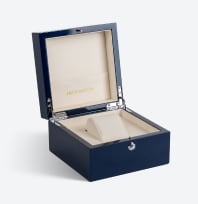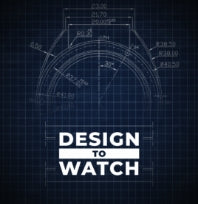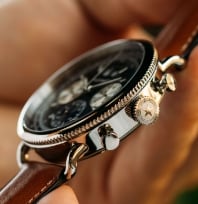Racing
Many of us know what it’s like to have a bit of a speed demon inside of us and to be more than a little curious about how quickly something can be done. Whether that refers to the glide of tires on a road, the speed of an aircraft, the pace of a runner, or how quickly one can do a given activity, there’s long been both a desire and need to precisely measure the start and end of things.
Sorry, there are no products in this collection
Though racing watches may be commonly associated with automobiles, their history starts well before then, with the skies themselves. Racing watches generally feature chronograph functionality, integrating both a stopwatch and tachymeter to help measure both lap times as well as speed.
The first chronograph was invented in 1816, though it was only recently rediscovered, rewriting the history of the timepiece itself. Called the “compteur de tierces,” or “counter of thirds,” the timepiece did not measure in the way a watch does but did include stopwatch functionality. While it was the first chronograph, it was not the first popular chronograph.
The distinction of the first commercial chronograph goes to a design by Nicolas Mathieu Rieussec, who in 1821 created a timepiece at the behest of King Louis XVIII to measure lap times in horse races. Two decades later, a reset function would appear to aid the binary start-stop chronograph, quickly bringing them to a modernly recognizable format.
In the 20th century, another common feature of racing watches appeared on timepieces: The tachymeter. Whereas a stopwatch simply measures time elapsed, the tachymeter serves to calculate speed over time.
It can be used generally to estimate given speed over a certain period of time by generally measuring distance traveled in “units.” These units can then be adjusted to whatever metric is needed, whether that be miles, kilometers, or something else.
Chronographs and racing watches go hand in hand because of the extent to which racing watches use chronograph functionality for timing purposes. Chronographs also see use in diving watches, where they can be used to measure how long one has been underwater and piloting airplanes where they serve much the same purpose: timing and calculating speed that they serve in racing watches.
All in all, racing watches are an essential piece of gear that provides much more than just racing. Chronograph functionality is one of the most common modern watch complications, thanks to their wide range of applications. With the history explained, it’s time to examine Jack Mason’s offering to this great timekeeping tradition.
Read MoreLessMirabeau Chronograph
Though it can be worn anywhere and in any context, the Mirabeau Chronograph takes some of its principle design cues from the appeal of mid-century sports cars. The chronograph pushers are brightly chromatic, and the crown is made with a subtle diamond pattern that gives it a unique tactile feel when examining it. The Chronograph shows its complexity when it comes to the dial of the watch. The watch featured a tachymeter along the circumference as well as interior subdials to allow for accuracy befitting a high-powered chronograph. On the dial itself, indices mark the hours, with a double marking for the 12 o’clock position and a red mark at the 6 o’clock position to highlight the date window inset there. Turning the lights out reveals an additional feature in the form of SuperLuminova luminosity markings on both the hands and indices. The more complex a watch's internal components for complications are, the larger the watch case needs to be. This particular timepiece features a 40mm case with a subtle bit of thickness, creating a mid-sized watch that boasts an impressive silhouette without ever appearing bulky. Speaking of internal components, the Mirabeau is powered by a Miyota OS21 movement for accuracy in regular timekeeping and chronograph functionality.Quality Construction
A great car is built to last, and the same holds true for a great watch. The tongue of the strap buckle is machine-processed from stainless steel to offer increased durability compared to traditional processes. The sapphire crystal is made from a highly scratch-resistant material that is second only to diamond when it comes to protection. The case is made from 316L surgical grade stainless steel, which is highly resistant to chemicals and corrosion even among stainless steel composites. Water resistance: Lastly, with 100 meters of water resistance, the Mirabeau goes above and beyond the expectations of a sports watch so that you won’t have to worry about moisture damaging your timepiece. One additional design feature of the Mirabeau exists to dispel any doubt that it was built from the ground up as a racing watch. Examining the back of the watch reveals a uniquely crafted pattern in the form of the sculptural caseback. Here, an intricately designed steering wheel is imprinted over the pattern of a tire tread. It is flanked by the Jack Mason name, model number, and various other enumerated design choices made to make the Mirabeau the best it can be.A Variety of Stylings
Though the Mirabeau Chronograph represents just one particular watch, it is available in three distinct styles, which are distinctive enough they deserve individual attention. All three use stainless steel cases and feature the aforementioned caseback rendition of a steering wheel and tire tread. The first of these showcases a white dial and a tan leather strap. Here, simple colorings are used to achieve a classically colored, highly practical chronograph. The pure color of the dial is matched by elegant, gold-colored hands and indices, as well as understated black lettering on the dial, subdials, and tachymeter. A splash of color is added by a red marker at the 6 o’clock position indicating the date window, as well as a slender red chronograph hand. The second styling is ruggedly contrasting, with a silver dial and black perforated leather strap. Here black hands, indices, as well as a black tachymeter all come together to call attention to the dial, which showcases the same red chronograph hand and date window index featured in the previous model. The subdials are also unique, with one being pure black with white lettering and the other separated into three equal sections, which are colored red, black, and cyan. The third version of the Mirabeau Chronograph is no less visually impressive, featuring a sky blue sunray dial that matches well with a perforated tan leather strap. Subtlety is the key here, with silver indices and a plain white tachymeter adding complexity to the watch without taking focus away from the dial. The same multicolored subdials are represented here, with one being silver-colored and the other uniquely separated into grey, red, and grey-blue, chosen for how they complement the sky blue dial.Choosing Your Mirabeau
While each variation of Jack Mason’s Racing Chronograph features the same internal components, the visual language of each is different. The version with a white dial and tan leather strap maintains functionality while providing traditional coloring, making it great for business settings or for those who find themselves switching contexts throughout the week. However, the version with a black perforated leather strap and white dial uses a bold, eye-catching aesthetic design. This makes it great for casual, athletic settings or anywhere you want to show off your watch without it taking over your whole outfit. Striking a middle ground between these two is the version with the sky blue dial and tan perforated leather strap, whose conservative colorings mix with colored subdials to create a watch that’s right at home in all but the most formal contexts. Also up for consideration is the strap. While the case is most often examined when it comes to testing the mettle of a watch, the strap of a watch is just as instrumental when it comes to the visual impression it gives. Leather, stainless steel, and rubber straps all have their own place, which is why Jack Mason includes quick-release pins in our designs so that you can customize your timepiece to match your context and personal style with any of our 20mm straps. While all of our watches use full grain Italian leather to maintain quality in all things, the perforated straps cannot at this time be purchased separately and are exclusive to the Mirabeau model they come with. It would be false to say that one version of this multifaceted offering is better than another, but one thing can be said for certain: Whatever your aesthetics and whatever your context, there’s a Mirabeau to suit any occasion.Finishing the Race
In the centuries since their first appearance, chronographs have taken their exclusive gaze from the skies above us to provide one of the most widely applicable watch complications on the market. The next time you click a stopwatch, whether timing a race or timing your own speed, you’ll be better able to understand the history which has made it possible. Plus, thanks to the Mirabeau Chronograph, you’ll be able to do so in style.








